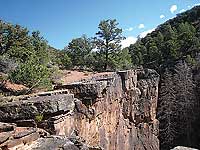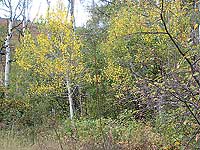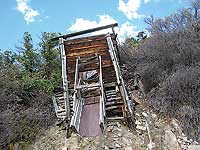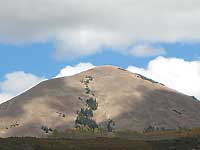Deep in Gold Basin far beneath the towering peaks of Tukuhnikivatz, Tuk No and Laurel, a heartbeat of water is born. More than a century ago, prospectors searched for gold along the pulsating banks, a man named Brumley operated a sawmill and a rugged dirt road wandered along the creek’s coursing waters. 
The miners are long gone, but Brumley’s quirky, illusive personality still beats on. During the full flush of spring runoff, its waters crazily surge on a crash course to join Pack Creek. After that wild fling, most of Brumley Creek strangely disappears - meaning sometimes you see it, sometimes you don’t. By late summer while crossing over the Squaw Springs Trail this intermittent stream usually fizzles down to a trickle before shyly tucking away underground. So a short distance farther, what a surprise it is to see Brumley re-emerging in a waterfall tumbling down a crack in a rock wall.
By the time this unpredictable flow reaches the pinyon-juniper country, it usually hunkers down again below the surface where enough moisture sustains a wealth of water-loving plants and trees. But whenever we are blessed with an abundance of rain, this secretive flow of water crawls out from under and bounteously runneth over.
 With winter coming to the high country, I reluctantly move my hiking agenda down to more temperate elevations. Lower Brumley Creek is the perfect location for that transition. To get there, I head south out of town on Highway 191 for about eight miles and turn left at the sign for Ken’s Lake-La Sal Loop Road. At the stop sign I turn right on to Spanish Valley Drive, which quickly becomes the La Sal Loop Road. Then I drive approximately 8.5 more miles, and shortly after mile marker 15,
With winter coming to the high country, I reluctantly move my hiking agenda down to more temperate elevations. Lower Brumley Creek is the perfect location for that transition. To get there, I head south out of town on Highway 191 for about eight miles and turn left at the sign for Ken’s Lake-La Sal Loop Road. At the stop sign I turn right on to Spanish Valley Drive, which quickly becomes the La Sal Loop Road. Then I drive approximately 8.5 more miles, and shortly after mile marker 15,
I turn right on to an old mining road.
Near the beginning of the road at 7100 feet, I park, grab my pack and start my hike as I notice the pinyons are pregnant with a heavy harvest of pine nuts. Instantly I’m tuning in to the early morning greeters – the drawn out “kra-a-a” of the Clark’s nutcracker - the tin-horn trumpeting of the red-breasted nuthatch – the tinkling trills of a small collection of juncos – and the low pitched nasal “chortle” of the white-breasted nuthatch. What a joyous way to start my day!
 Just barely hitting my stride, I suddenly slam on the brakes to focus on the big picture – an expansive landscape of mesas, plateaus and canyons that stretch for miles and miles until it bumps up against the spellbinding silhouette of the Henry Mountains, directly west, and the Abajos to the southwest – a portrait that always fascinates me.
Just barely hitting my stride, I suddenly slam on the brakes to focus on the big picture – an expansive landscape of mesas, plateaus and canyons that stretch for miles and miles until it bumps up against the spellbinding silhouette of the Henry Mountains, directly west, and the Abajos to the southwest – a portrait that always fascinates me.
Eventually I tear myself away and continue on to another must-stop spot above a cliff wall decoratively marbled with varying shades of brown, black, yellow and gray - a formidable sandstone fortress overlooking the confluence of the Brumley and Dorry drainages. From the creek’s nourishing bottom Douglas firs shoot up straight and tall, while on top prickly pear cactus precariously cling to the edge, where bolts mark the evidence of climbing activity.
After a short walk along the edge, I leave my cliffside balcony and wander back to the road. Before long, I approach a log fence with an easy-to-open gate. A little farther, as I parallel the dry creek channel, a wonderful transition awaits my arrival. Here I find a riparian paradise filled with the musky, cidery flavor of fall – the smoky red-orange-yellow hues of oaks - the breeze-tossed golden aspens - the melancholy lemon of box elders – all accompanied by the crackling leaf-crunch underfoot.
At approximately 1.5 miles in to my fallish hike, a seldom-used crossing over Brumley’s dry belly could easily be missed. At this point a different 4X4 trail commences an interesting loop to a ridge with several deserted uranium mines. I, however, choose to proceed on the more obvious track that passes a series of miniature cliffs bunched up beside the road, where water unexpectedly bubbles to the surface.
By now, the small clouds of morning are gathering into a convention of talking up the possibility of rain. Hey wait a minute – the weatherman promised me a sunshiny day! A soaking rain I definitely do not need. When wet, this road takes on the consistency of gumbo, which turns walking in to a slow, mucky slog.
 After covering another mile I reach a major fork, where I decide to go left rather than swing right to cross the creek. But first things first, I am so ready for a break. An appealing creek side location calls my name beckoning me to take a load off my feet – a special spot where I can close my eyes and listen to the creek’s soft murmurings as it splashes along the rocky bottom. On this grassy embankment I can sit among the aspens and watch them leaf-dance against a dramatic sky, which is quickly changing from innocent blue to threatening black!
After covering another mile I reach a major fork, where I decide to go left rather than swing right to cross the creek. But first things first, I am so ready for a break. An appealing creek side location calls my name beckoning me to take a load off my feet – a special spot where I can close my eyes and listen to the creek’s soft murmurings as it splashes along the rocky bottom. On this grassy embankment I can sit among the aspens and watch them leaf-dance against a dramatic sky, which is quickly changing from innocent blue to threatening black!
During this refreshing pause, I marvel at the exquisite markings of a late season Weidemeyer’s Admiral – a glossy black butterfly edged by a band of ivory white. Alas, this refreshing interlude ends too soon, but curiosity urges me onward to see what lies ahead at the end of the road. Quickly this exploration brings me to an abandoned mine – a reminder of the thirty year “uranium frenzy” that started in the early 1950s.
As I continue to gain elevation I once again return to the pinyon-juniper country. Now I can gaze down on the greenness of Brumley’s drainage as I muse, “Wow - I’ve been doing a lot of climbing.” And then checking ahead: “Oh brother, there’s still plenty of uphill left!”
Phew! At last, the terrain levels out, and before long this road, route 0068, ends at the Geyser Pass Road where I am rewarded with a great view of Haystack Mountain. Covering 3.7 miles, I have gained 1200 feet in elevation! No wonder I am pooped, so I plop down for a quick break before retracing my footsteps. At least, it’s mostly downhill, and the diminishing clouds have acquired a more friendly appearance. Fortunately they were all talk and no action!

 With winter coming to the high country, I reluctantly move my hiking agenda down to more temperate elevations. Lower Brumley Creek is the perfect location for that transition. To get there, I head south out of town on Highway 191 for about eight miles and turn left at the sign for Ken’s Lake-La Sal Loop Road. At the stop sign I turn right on to Spanish Valley Drive, which quickly becomes the La Sal Loop Road. Then I drive approximately 8.5 more miles, and shortly after mile marker 15,
With winter coming to the high country, I reluctantly move my hiking agenda down to more temperate elevations. Lower Brumley Creek is the perfect location for that transition. To get there, I head south out of town on Highway 191 for about eight miles and turn left at the sign for Ken’s Lake-La Sal Loop Road. At the stop sign I turn right on to Spanish Valley Drive, which quickly becomes the La Sal Loop Road. Then I drive approximately 8.5 more miles, and shortly after mile marker 15, Just barely hitting my stride, I suddenly slam on the brakes to focus on the big picture – an expansive landscape of mesas, plateaus and canyons that stretch for miles and miles until it bumps up against the spellbinding silhouette of the Henry Mountains, directly west, and the Abajos to the southwest – a portrait that always fascinates me.
Just barely hitting my stride, I suddenly slam on the brakes to focus on the big picture – an expansive landscape of mesas, plateaus and canyons that stretch for miles and miles until it bumps up against the spellbinding silhouette of the Henry Mountains, directly west, and the Abajos to the southwest – a portrait that always fascinates me. 
 After covering another mile I reach a major fork, where I decide to go left rather than swing right to cross the creek. But first things first, I am so ready for a break. An appealing creek side location calls my name beckoning me to take a load off my feet – a special spot where I can close my eyes and listen to the creek’s soft murmurings as it splashes along the rocky bottom. On this grassy embankment I can sit among the aspens and watch them leaf-dance against a dramatic sky, which is quickly changing from innocent blue to threatening black!
After covering another mile I reach a major fork, where I decide to go left rather than swing right to cross the creek. But first things first, I am so ready for a break. An appealing creek side location calls my name beckoning me to take a load off my feet – a special spot where I can close my eyes and listen to the creek’s soft murmurings as it splashes along the rocky bottom. On this grassy embankment I can sit among the aspens and watch them leaf-dance against a dramatic sky, which is quickly changing from innocent blue to threatening black!